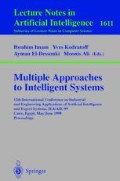Abstract
This paper presents a strategy to handle incomplete knowledge during acquisition process. The goal of this research is to develop formal tools that benefit the law of semantic balance. The assumption is used that a situation inside the object’s boundary in some world should be in balance with a situation outside it. It means that continuous cognition of an object aspires to a complete knowledge about it and knowledge about internal structure of the object will be in balance with knowledge about relationships of the object with other objects in its environment. It is supposed that one way to discover incompleteness of knowledge about some object is to measure and compare knowledge about its internal and external structures in an environment. If there exist differences between the internal and the external semantics of an object, then these differences can be used to derive more knowledge about the object to make knowledge complete. The knowledge refinement process is done step-by-step as a continuous evolution of a knowledge base. Each step consists first automatic analysis of semantic balance which is then followed by attempts to derive knowledge that will balance differences between internal and external semantics of the object. This paper describes an algebra that is used to describe the internal and external semantics of an object and to derive unknown part of it. The results presented are mostly theoretical ones.
Access this chapter
Tax calculation will be finalised at checkout
Purchases are for personal use only
Preview
Unable to display preview. Download preview PDF.
References
Bondarenko, M., Grebenyuk, V., Terziyan, V.: Reasoning Based on the Algebra of Semantic Relation. Pattern Recognition and Image Analysis 3(4), 488–499 (1993)
DeJong, G., Bennett, S.: Permissive Planning: A Machine Learning Approach to Linking Internal and External Worlds, pp. 508–513. AAAI Press/MIT Press, Menlo Park (1993)
Grebenyuk, V., Kaikova, H., Terziyan, V., Puuronen, S.: The Law of Semantic Balance and its Use in Modeling Possible Worlds. In: STeP 1996 - Genes, Nets and Symbols, pp. 97–103. publications of the Finnish AI Society (1996)
Heylighen, F., Bollen, J.: The World Wide Web as a Super-Brain: From Metaphor to Model. In: Proceedings of the 13-th European Meeting on Cybernetics and Systems Research, pp. 917–922. Austrian Society for Cybernetic Studies (1996)
Kamimura, R.: Generation of Inhibitory Connections to Minimize Internal and External Entropy. In: Alexander, I., Taylor, J. (eds.) Artificial Neural Networks, vol. 2, pp. 969–972. North Holland, Amsterdam (1992)
Larson, R., Segal, G.: Knowledge of Meaning. An Introduction to Semantic Theory. A Bradford Book, Mass (1995)
Li, L.: Possible World Semantics and Autoepistemic Reasoning. Artificial Intelligence 71(2) (1994)
Morik, K.: Balanced Cooperative Modeling. Machine Learning 11(2/3) (1993)
Puuronen, S., Terziyan, V.: A Metasemantic Network. In: STeP-1992 - New Directions in Artificial Intelligence, pp. 136–143. publications of the Finnish AI Society (1992)
Schultz, T.R., Mareschal, D., Schmidt, W.C.: Modeling Cognitive Development on Balance Scale Phenomena. Machine Learning 16(1/2) (1994)
de la Sen, M., Jugo, J.: Robust Control for a Class of Systems with Internal and External Point Delays. In: Cybernetics and Systems 1994, pp. 191–198. World Scientific Publishing, Singapore (1994)
Willkins, D.C.: Knowledge Base Refinement as Improving an Incorrect and Incomplete Domain Theory. In: Buchanan, B.G., Wilkins, D.C. (eds.) Readings in Knowledge Acquisition and Learning, pp. 631–641. Morgan Kaufmann, Calif (1993)
Author information
Authors and Affiliations
Editor information
Editors and Affiliations
Rights and permissions
Copyright information
© 1999 Springer-Verlag Berlin Heidelberg
About this paper
Cite this paper
Terziyan, V.Y., Puuronen, S. (1999). Knowledge Acquisition Based on Semantic Balance of Internal and External Knowledge. In: Imam, I., Kodratoff, Y., El-Dessouki, A., Ali, M. (eds) Multiple Approaches to Intelligent Systems. IEA/AIE 1999. Lecture Notes in Computer Science(), vol 1611. Springer, Berlin, Heidelberg. https://doi.org/10.1007/978-3-540-48765-4_39
Download citation
DOI: https://doi.org/10.1007/978-3-540-48765-4_39
Publisher Name: Springer, Berlin, Heidelberg
Print ISBN: 978-3-540-66076-7
Online ISBN: 978-3-540-48765-4
eBook Packages: Springer Book Archive

